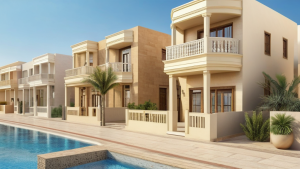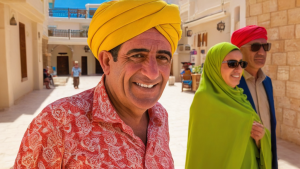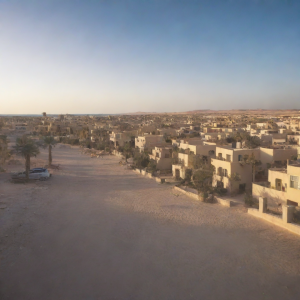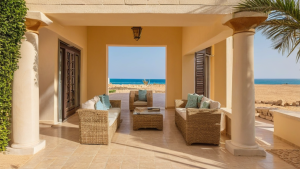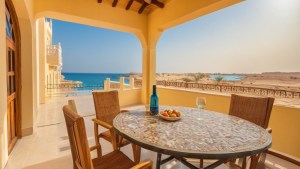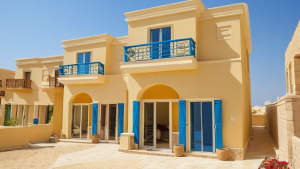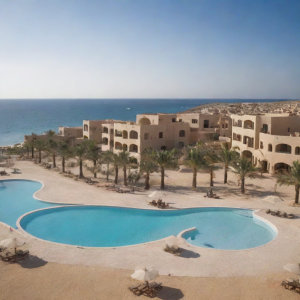Summary about owning and buying property in Hurghada, Egypt.
- When exploring the real estate market in Hurghada, one key aspect that sets luxury villas apart from budget options is the choice of materials used in construction and finishing.
- The difference in material quality directly influences not only the durability and functionality of a villa but also its aesthetic appeal and overall value.
- Whether you are an investor, a homebuyer, or a design enthusiast, understanding the variations in materials is essential to making informed decisions.
- Windows and doors in luxury villas feature hardwood frames or high-quality aluminum profiles with double or triple glazing.
- Additionally, the aesthetic options for doors and windows are more limited in budget villas, with simpler designs and finishes.
Comparing materials used in luxury and budget villas in Hurghada: quality and aesthetics
When exploring the real estate market in Hurghada, one key aspect that sets luxury villas apart from budget options is the choice of materials used in construction and finishing. The difference in material quality directly influences not only the durability and functionality of a villa but also its aesthetic appeal and overall value. Whether you are an investor, a homebuyer, or a design enthusiast, understanding the variations in materials is essential to making informed decisions.
Structural materials: foundation of strength
Luxury villas in Hurghada often utilize premium-grade concrete and reinforced steel with increased density and tensile strength. These materials ensure enhanced stability, resistance to environmental factors such as salty sea air, and longevity. Designers tend to use stronger foundations in luxury homes to support expansive layouts and heavier finishes.
In contrast, budget villas may rely on more basic concrete mixes and lighter steel reinforcements. While still compliant with safety standards, these materials often emphasize cost-efficiency over long-term robustness. As a result, budget villas might require more maintenance over time, especially in coastal climates.
Exterior finishes: style meets functionality
The choice of exterior cladding and coatings plays a significant role in setting luxury residences apart. For upscale villas in Hurghada, natural stone veneers, high-quality stucco, and weather-resistant paints with UV protection are common. Natural stone, such as granite, marble, or limestone, provides a timeless elite look and excellent insulation, maintaining interior comfort zones.
Budget villas, however, often use more economical materials like cement-based plaster or synthetic paint finishes. While these materials provide acceptable aesthetics at first glance and offer protection, they tend to wear off more quickly under intense sun and coastal humidity, requiring earlier refurbishments.
Flooring: comfort and elegance underfoot
Floors in luxury homes often feature premium materials such as imported marble, hardwood, or high-grade porcelain tiles. These materials not only elevate the ambiance with their rich textures and glossy finishes but also last for decades when properly maintained. Marble floors offer natural cooling, ideal for Hurghada’s warm climate, while hardwood adds warmth and sophistication to living spaces.
Budget villas typically incorporate local ceramic tiles or laminate flooring, which are cost-effective and fairly durable. These materials might lack the luxurious feel and can show signs of wear faster, but they provide a practical flooring solution that balances affordability with decent functionality.
Windows and doors: security and style
Windows and doors in luxury villas feature hardwood frames or high-quality aluminum profiles with double or triple glazing. These options provide enhanced insulation against heat and noise while offering superior security features like multi-point locking systems. The glass often comes with protective coatings that reduce solar heat gain and glare, improving energy efficiency.
Conversely, budget properties usually have aluminum or uPVC frames with single or double glazing. While these materials are economical and sufficiently secure, they do not offer the same thermal efficiency or sound insulation as their luxury counterparts. Additionally, the aesthetic options for doors and windows are more limited in budget villas, with simpler designs and finishes.
Interior walls and ceilings: attention to detail
Luxury villas frequently showcase plaster walls finished with multiple layers of premium paint or textured wall coverings. Some designers incorporate decorative elements such as intricate moldings, wood paneling, or stone accents, which contribute to an exclusive and refined interior atmosphere. Ceilings may also include advanced lighting setups and suspended designs for a dramatic effect.
Budget villas, on the other hand, mostly feature standard plaster or drywall with a single coat of functional paint. While clean and serviceable, these finishes are minimalistic and focus on basic usability rather than luxury aesthetics. Ceilings tend to be flat with basic lighting fixtures, reflecting the cost-conscious approach.
Kitchen and bathroom fixtures: combining durability with style
Luxury villas in Hurghada use high-end cabinetry made from solid wood or waterproof MDF with custom finishes. Countertops are commonly crafted from natural stone like granite, quartz, or marble, which add to the luxurious feel and resist stains and scratches. Fixtures such as faucets, sinks, and showerheads come from premium brands that offer durability and elegant design.
For budget villas, kitchens and bathrooms typically feature laminate cabinetry and synthetic countertops such as engineered stone or basic granite composites. Fixtures are practical but may lack the refinement and longevity of luxury products. These choices ensure affordability but might necessitate replacements or upgrades sooner.
Outdoor spaces: materials that enhance lifestyle
The landscaping and external amenities of luxury villas in Hurghada often include natural stone pavements, hardwood decks, and custom-built pergolas made from premium woods or metal alloys. Swimming pools are finished with tiles or mosaics, ensuring both beauty and durability. Lighting fixtures in outdoor areas are selected for ambiance and security, integrating seamlessly with the architectural style.
Budget villas usually incorporate simpler choices like concrete or basic tile patios, with limited custom features. Wooden elements are less frequent due to costs, and pools, if present, are finished with standard plaster or tiles that are functional but less decorative. Outdoor lighting tends to be minimal, emphasizing practicality.
Summary of key material differences
- Structural Strength: High-density concrete and reinforced steel in luxury villas vs. standard mixes in budget options.
- Exterior Finishes: Natural stone and premium paint vs. cement plaster and synthetic paint.
- Flooring: Marble, hardwood, porcelain tiles vs. ceramic tiles, laminate floors.
- Windows and Doors: Hardwood/aluminum with triple glazing vs. aluminum/uPVC with single or double glazing.
- Interior Finishes: Multi-layer paint, decorative moldings vs. single paint coat, basic drywall.
- Kitchen/Bathroom: Solid wood cabinets, natural stone countertops vs. laminate cabinets, synthetic surfaces.
- Outdoor Amenities: Natural stone paving, custom-built features vs. basic tiles, limited landscaping.
By carefully choosing materials, developers and homeowners in Hurghada can tailor villas to suit various budgets without compromising entirely on safety and function. However, the superior materials used in luxury villas do not just represent higher costs,they also deliver greater longevity, comfort, and aesthetic value. This distinction is crucial if you want your property to stand out or maintain its worth over time in Hurghada’s dynamic real estate market.
How material choices impact the durability and maintenance of villas in Hurghada
Understanding material selection in Hurghada villas
When building or investing in a villa in Hurghada, the materials used play a crucial role in the property’s longevity and upkeep. The city’s coastal environment, marked by salty air, high humidity, and intense sun exposure, places unique demands on construction materials. These factors influence how well a villa withstands wear and tear over time, affecting both durability and the frequency of maintenance required.
Choosing the right materials is especially important when comparing luxury villas to budget options in Hurghada. Luxury developments often use premium, weather-resistant materials that minimize upkeep, while budget villas may rely on more cost-effective but less durable solutions.
High-quality materials in luxury villas
Luxury villas in Hurghada prioritize materials that ensure long-term performance and aesthetic appeal. These choices typically involve higher upfront costs but translate into fewer repairs and maintenance tasks down the line.
Stone and marble finishes
Natural stone, such as granite or marble, is a popular choice for flooring, countertops, and cladding in high-end villas. These materials:
- Are highly resistant to weathering and moisture.
- Provide a timeless, elegant look that maintains its value.
- Require minimal sealing and polishing to retain their shine.
In Hurghada’s salty atmosphere, marble and granite resist corrosion better than synthetic options, making them wise investments.
Advanced concrete and reinforcements
Luxury builds often incorporate specialized concrete mixes with additives that improve strength and reduce permeability. Coupled with stainless steel reinforcements, this combination:
- Prevents cracking and structural damage from humidity and temperature shifts.
- Limits chloride ingress from the sea air, protecting the building’s core.
- Extends overall building lifespan.
Premium wood and composite materials
Wood enhances the warmth and style of villas, especially when used for cabinetry, doors, and decorative elements. In luxury villas:
- Teak, mahogany, and other hardwoods are common, treated to resist termites and moisture.
- Composite decking materials, often used on terraces, offer the look of wood with greater durability against rot and fading.
High-performance glass and metal fixtures
Windows and doors in upscale villas incorporate double-glazed glass with UV protection and aluminum or powder-coated frames. These materials:
- Reduce heat gain, enhancing energy efficiency.
- Resist corrosion better than standard metal options.
- Require less frequent replacement and cleaning due to specialized coatings.
Material choices in budget villas
Budget villas in Hurghada focus on cost savings, often leading to the use of materials with shorter lifespans or higher maintenance needs.
Standard concrete and basic finishes
Budget villas usually utilize traditional concrete without advanced additives, which may be more prone to surface cracking and moisture infiltration. The paint and plaster finishes might also use lower-quality compounds more susceptible to fading and peeling, especially in the harsher coastal climate.
Economical flooring options
Instead of natural stone, budget villas often opt for ceramic tiles or laminate flooring, which:
- Are cheaper and easy to install
- Can deteriorate quickly with exposure to humidity and salt
- May require frequent replacement or repairs over time
Affordable wood and metals
Cheaper woods and untreated varieties can be prone to termite damage and warping in budget villas. Metal fixtures such as window and door frames may be made from regular steel, which corrodes faster without adequate protective coatings. These choices typically increase maintenance work and costs.
How material durability affects maintenance
The durability of construction materials directly influences how much maintenance a villa will need in Hurghada:
- Durable materials reduce the frequency of repairs. High-quality stone floors or treated hardwood that withstand salt exposure will keep their appearance longer with less upkeep.
- Weather-resistant coatings limit damage. Paints and sealants designed for coastal areas prevent moisture ingress and wood rot.
- Corrosion-resistant metals prolong fixture life. Premium window frames resist rust, reducing the need for replacement or repainting.
- Efficient protective treatments save money. Investing in surface treatments upfront can lower long-term maintenance costs.
Balancing costs and longevity for your villa
When selecting materials for a villa in Hurghada, it helps to weigh initial costs against future expenses. While luxury villas invest in superior materials enhancing durability and minimizing maintenance, budget villas may face higher upkeep costs due to less resilient choices.
For homeowners and investors, understanding how material quality impacts a villa’s lifespan and care can inform smarter decisions. Prioritizing materials designed for Hurghada’s environment not only protects your property but also ensures comfort and value over many years.
When choosing between luxury and budget villas in Hurghada, the materials used play a crucial role in defining both the property’s look and its longevity. Luxury villas often showcase high-quality materials like natural stone, imported tiles, and premium wood, which not only elevate the aesthetic appeal but also provide greater durability. These materials resist harsh coastal weather and require less frequent maintenance, ensuring that the villa remains pristine over time.
On the other hand, budget villas typically use more cost-effective materials such as basic concrete, local tiles, and standard paints. While these materials help keep the price accessible, they may not hold up as well against wear and environmental factors. This can lead to higher maintenance costs and shorter lifespans for certain features.
Ultimately, understanding the difference in material quality helps you make a smarter investment decision. If you value long-term durability and sophisticated design, a luxury villa’s superior materials will likely meet your expectations better. However, if you are aiming for affordability and are prepared for some upkeep, budget villas offer a practical option. Being clear about how material choices affect both appearance and maintenance will guide you in selecting a villa in Hurghada that aligns well with your lifestyle and financial goals.


